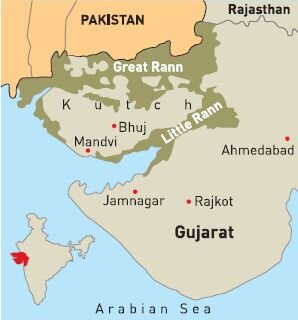Biodiversity & Environment
Kutch Desert
- 22 Aug 2019
- 4 min read
The study of fossils from Kutch in Gujarat has revealed that the hot arid desert of Kutch was once a humid subtropical forest.
- Findings of Study: The fossil from Palasava suggest that a rich diversity of fauna and flora sustained in warm, humid/wet, tropical to sub-tropical environmental conditions during the Middle Miocene.
- The bulk of fossils unearthed in Kutch have so far been mainly marine organisms, due to their proximity to the Arabian Sea. Geological changes eventually closed off the salt-flats’ connection to the sea and the region turned into a large lake, eventually becoming salty wetlands.
- It points to clues on how mammals dispersed between Africa and the Indian subcontinent when part of India was in the Gondwanaland supercontinent that existed nearly 300 million years ago.
Kutch Desert
- Kutch Desert covers a vast area of 45,612 sq. km and is bounded to the north and northwest by Sindh (Pakistan), west and southwest by the Arabian Sea, and to the northeast by Rajasthan.
- The Rann of Kachchh comprises a unique example of Holocene sedimentation. It covers a large tracts of 23,000 sq. km and has been arbitrarily divided into two parts namely the Great Rann and Little Rann.
- Kachchh furnishes an interesting example of four diverse geomorphic type of terrain namely (i) the Rann, (ii) the low lying Banni plains, (iii) the hilly region, and (iv) the coastal plains.
- Such physiographic diversity is a reflection of geology, climate and sea level changes in this region
- It is connected to the Arabian Sea through Kori Creek in the west and the Gulf of Kachchh in the east, and is very close to sea level.
- The Wild Ass Wildlife Sanctuary, situated in the Indian state of Gujarat, is the largest wildlife sanctuary in the country. It is spread in the entire area of the little Rann of Kutch where small grass-covered areas, known as baits, forms the flora and is an important source to support the fauna of the region.
Holocene Epoch
- Holocene Epoch,is the latest interval of geologic time, covering approximately the last 11,700 years of Earth’s history.
- The sediments of the Holocene, both continental and marine, cover the largest area of the globe of any epoch in the geologic record.
- The Holocene is unique because it is coincident with the late and post-Stone Age history of humankind. The influence of humans is of world extent and is so profound that it seems appropriate to have a special geologic name for this time.
Miocene Epoch
- The Miocene epoch is a major division of the geologic timescale and extends from about 23.03 to 5.332 million years before the present.




